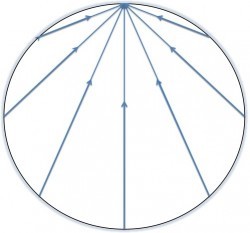I spent my 50th birthday at the most boring meeting of my life. At one point I had to pinch myself under the table to keep from falling asleep. I’ve attended a lot of meetings that are a waste of time – it’s part of my job. (I help teams improve their performance and often observe to understand their issues before I intervene). However, I must say this was the most boring meeting of my career.
I was observing a four-hour team meeting of the company’s president and his eight direct reports. Sitting around a table, one at a time each person reported what was happening in his or her area. The president asked questions. The others listened until it was their turn. There was no real discussion.
I sometimes map the energy flow by drawing an arrow each time someone speaks to another person. The energy flow at this meeting looked like this, with the president being the focal point of the meeting.

What was the purpose of the meeting? Although it was not articulated, it was clear that the purpose was to share information with the president in the most time efficient manner —for the president.
Besides being a waste of everyone else’s time, a huge opportunity was lost. The senior leadership of this company had gathered together and had not taken advantage of the opportunity for the team to provide leadership for the company as a whole.
Holding a meeting to keep people informed is not a good reason to meet. There are a lot of effective alternatives for sharing information.
If the energy flow in your meeting looks like the above diagram for an extended period of time, most likely your meetings are not necessary.
The only good reason for a team to meet is to create and tap into the collective wisdom.
The map of energy flow, over time, should look closer to this:

Three steps to determine whether a meeting is necessary.
1. Identify the meeting purpose – why you need to meet. If the purpose doesn’t include one of these reasons, don’t call a meeting.
- To make joint decisions using everyone’s best thinking
- To work together on things you cannot accomplish as well working separately
- To utilize each other’s expertise
- To create a common perspective – everyone hears the same thing at the same time, answer questions and create shared meaning
- To create a big picture view beyond each person’s individual area of responsibility
- To create and maintain alignment – ensure a shared vision (purpose, values and destination)
- To strengthen relationships and increase trust
2. List your desired outcomes for the meeting. Answer: “At the end of the meeting, what will have been accomplished?”
3. Build your agenda after you identify the purpose and desired outcomes. Make sure that each agenda item supports the purpose and drives one of your desired outcomes. If it doesn’t, take it off the agenda.
If you do host a meeting, don’t keep people in the dark. Provide a copy of the agenda with the purpose and desired outcomes at the top. It will help everyone stay focused, even if this is a regular meeting with a standing agenda.
Better yet, determine the purpose, desired outcomes and build the agenda with your team. That’s a worthwhile use of everyone’s time.













I had the pleasure of working for a man who KNEW how to do this; we even had a Big Idea Meeting once a month where EVERY single employee was able to offer a new idea to help our company and were rewarded quite handsomely for it.
After we were bought out I had the displeasure of working for a man who regularly, and I mean monthly, had meetings like the one you attended on his 50th birthday.
The company is now 1/4 the size it was before purchase. I am convinced your meeting style directly reflects your Leadership style, or lack thereof. GREAT post.
Hi Amy, Thanks for your real life examples of how it can go right and what happens when it’s done wrong!
Thank you for the great advice. I think I was in the same meeting you were in. I hope meeting “leaders” read this!
Me, too! Thanks, Lisa. 🙂
Your blog reminded me about the importance of having a clear purpose understood by all. So, I reviewed the purpose of our meetings last night on my monthly call with an advisory group that I chair. Thanks for the reminder!
Hi Fay, Thanks for taking the time to share your thoughts here. So glad my post was helpful.
I just added a “Desired Outcome” section at the top of my Meeting Agenda form.
I can already see how valuable it will become. Thanks!
Wonderful, Terry! I’d love to hear how it goes.
Great comments. Sorry you had to spend time in that meeting. I believe leaders get work done through the exchange of ideas and information with others. Usually this exchange occurs in meetings. If the information flow is one-way, there is very little “exchange” going on. So the ability to hold effective meetings is a key competency for leadership success. Somehow, we forget this until a reminder comes along like this one.
Another recent post highlights a change in meeting structure that Larry Page made when he took the helm again at Google. He wanted to change the culture of meetings and, among other points, asked that meeting size be limited to 10 people, and everyone should contribute. I’d love to know what a map of the energy flow would look like in his meetings, but I bet its pretty multi-dimensional. See the piece by Kristin Gil, VP of Business Operations on his “meaningful meetings” http://bit.ly/wGGN2H
Hi Rick, I agree that the “exchange” is essential for organizations to work successfully, and it can’t happen in silos. Unfortunately, all too often leaders re-create the silos in the very structure that can most help them provide leadership (team meetings). Thanks so much for sharing the story about Larry Page and also for the link.
This is a very useful post Jesse and I have tried various tools to facilitate the process you describe, some more successful than others! One strategy I have used to break the cycle of restricted unidirectional energy flow! is to suggest that the chair or meeting lead rotates. This breaks cycles of power and control being associated with leadership position in meetings and can really change the dynamic. It also gives the group an opportunity to experience other styles of chairing and skills that they suddenly learn have been present in their group all along. It shares accountability for group process and creates the opportunity for empathy. It is best done with small teams. Interested to hear your thoughts! Thanks for your insights.
Hi Helen,
I agree that this particular meeting was about the leader maintaining power and control. I usually begin with helping the leader and team identify their vision for their team – what they would look like if they were a high performing team. Next we identify what is getting in the way. Then we look at processes and structures to support it – such as agenda items, roles, etc. My experience is that leaders want their teams to perform well and are not aware that their behavior is sabotaging their own goals. Your suggestion of rotating the position of chair is an excellent strategy once the leader is willing to relinquish control. The more the team shares responsibility for it’s own success, the faster it will move toward high performance. Thanks for sharing your insights, Helen!
Hi Jesse,
While you’re right about the concept of efficient meeting in general, I couldn’t help but notice that your company works in silos (you can read more about silos here). For example, when each VP was reporting about his area, no one, save for the president, knew what he was talking about. It seems that the different areas in your company are not integrated properly.
Absolutely!
Thank you, Jesse, great post. You lay out how amazingly simple it can be to do meetings right, and yet it’s simply amazing how seldom it actually happens.
What comes through is that the key to success in a meeting depends on what happens outside the meeting. Joel DeLuca in his book “Political Savvy” says, “Group decisions are essential for effective organizations, and group settings are often the worst place to make group decisions. … Group meetings are the visible tip of the decisionmaking iceberg.”
Hi Daniel, Thanks for your kind words and for the reference to Joel DeLuca’s book. I agree that group setting are often the worst places to make group decisions, but THEY CAN ALSO BE THE BEST PLACES when done right. When a high performing team meets, they are able to quickly access all the issues and viewpoints and tap into a collective wisdom that doesn’t exist anywhere else. It’s important to bring the right topics to the table. When you do, meetings are not boring at all because everyone knows they are doing important work.
Jesse, I had to smile when I saw the energy-flow diagram, because it reminded me of the conversation pattern in my home around the dinner table. My young daughters constantly direct their conversation and eyes toward me, rather than engaging everyone around the table equally. It actually takes an effort on my part to remind them to include everyone in the conversation. I wonder how much of that pattern at the conference room table is a vestige of family patterns (sibling rivalry, anyone?), with everyone trying to curry favor with the “head of the household.” Reading this also makes me realize that it’s time to come up with some sort of game to cultivate a new pattern at the dinner table!
Hi Alice, Love that you saw the application of my post to your dinner table conversation. I think the biggest difference between you and the CEO is that YOU recognize the importance of including everyone in the conversation and are actively seeking ways to promote these skills. Wouldn’t it be nice if your daughters and others like them became the next generation of CEOs!
Great post thanks Jesse. Your comment about always giving an agenda with the purpose and desired outcomes at the top really resonated with me. Back when I was in corporate life I was well known for refusing to go to meetings without just that. It certainly improved meetings
Although writing out the purpose and outcomes can seem like extra time, it is the single most effective way I know to ensure the agenda topics are the right ones and to keep people focused during the meeting. One of my mentors, Don Carew, often said, “Take care of the beginning and the end will take care of itself.” Thanks for adding to the conversation, Jon!
Thus a goldmine is quite as prone to show on any spin, irrespective of prior results.